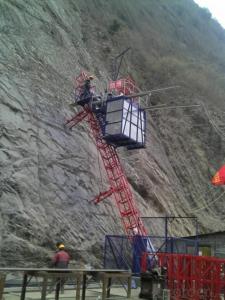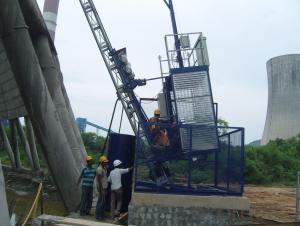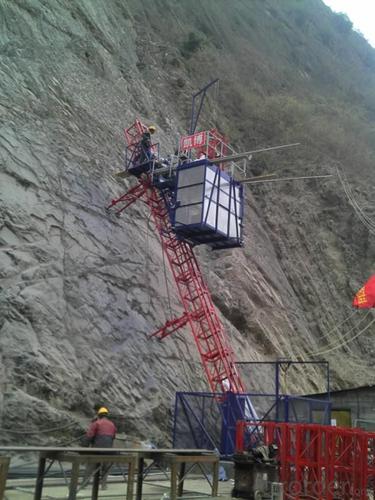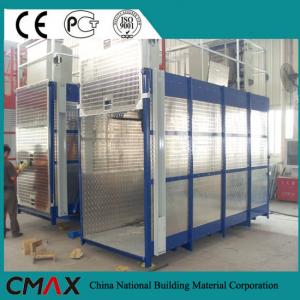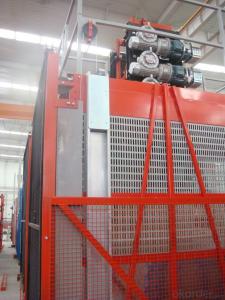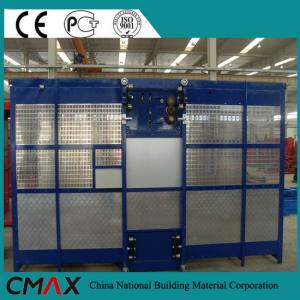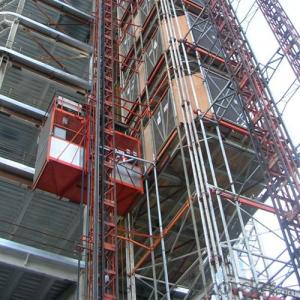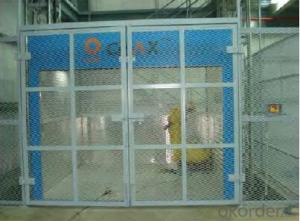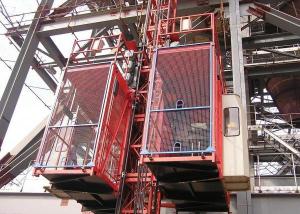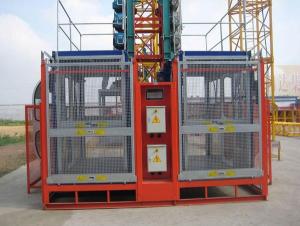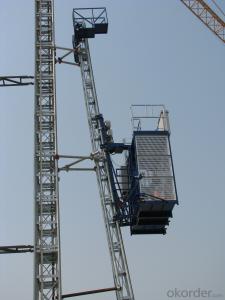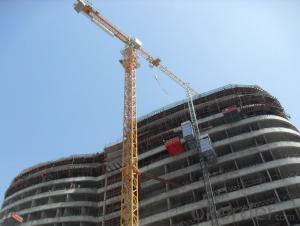SCX120 inclined Hoist
- Loading Port:
- Tianjin
- Payment Terms:
- TT or LC
- Min Order Qty:
- -
- Supply Capability:
- 30 units unit/month
OKorder Service Pledge
OKorder Financial Service
You Might Also Like
Building Hoist SCX120
Condition: New
Application: Construction
Payload(kg):1200
Lifting Speed(m/min):0~33
Motor Power(kw): 2*3*22
Safety Device: 2*SAJ50-1.4
Cage: Single cage
Counterweight: No
Certification: CE/ ISO
Place of Origin: China(Mainland)
Model Number: Type:SCX120
Packaging & Delivery of Building Hoist
Packaging Detail: Nude package Delivery Detail: 15-20days
Main Parts of Building Hoist
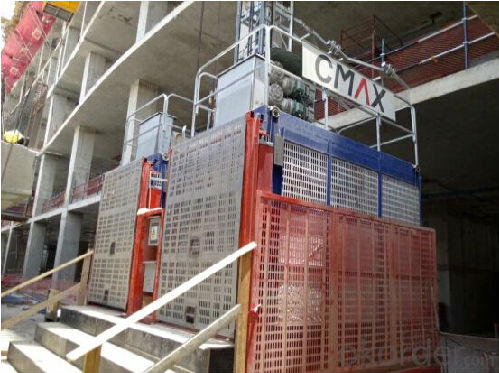
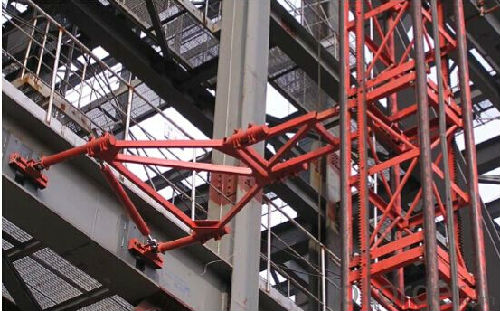

Feature:
● Adopts the most advanced VF speed control device and microcomputer programmable logic controller.
● Stepless speed control helps eliminate the concussion during start up and braking, steady the operation process,
and ensures automated leveling.
● Realizes accurate low speed positioning of the hoist and avoid slipping during downward stopping of hoist.
● The VF system has current-restriction function, ensuring a small current when motor start up and reducing the concussion to power supply.● The steadiness during running mitigates concussion to mechanical parts, reduces wears of rack, pinion and the brake
and prolongs the spare parts'life.
● The VF system also has the over voltage protection,low voltage protection, overcurrent, overload and anti-stalling protection functions,
● The system applies the special software for hoists developed by our company, making the operation more safe and
reliable.
Building Hoist Specifiction
FAQ of Building Hoist
Q: What is the building hoist main purpose?
A: Building hoist equipped with double or single cabin to transport the materials and labors up and down.
Q: What is the main structure of building hoist?
A: The P/M construction hoist mainly contains metal structure, driving system, electrical control system, cable guide &
protection system, electrical top crane.
Q: What is the meaning of the building hoist’s code?
A: capacity is 2 tons per cage. “SC200” stands for single cage and capacity is 2 tons.
Q: What is the dimension of the cage?
A: Normally the cage dimension is 3X1.5X2.5M (L/W/H) for 2t type hoist. Details should be checked according to our
quotation sheet. Also, the size can be customized according to the factual site condition. There are two doors (entrance
& exit doors) for each cage, It can be produced as up & down sliding or ramping model for safety and convenience.
- Q: This question asks for a comparison of the pros and cons of utilizing hydraulic cylinders in the context of building hoists.
- <p>Hydraulic cylinders in building hoists offer several advantages, including high force output, compact size, and precise control. They provide smooth and controlled lifting, which is crucial for heavy construction materials. Additionally, hydraulic systems can generate large amounts of force with relatively small cylinders, making them space-efficient. The disadvantages include potential leaks, which can be hazardous, and the need for regular maintenance to ensure the system's reliability. Hydraulic systems can also be more complex to install and repair compared to electric or manual systems. Furthermore, they require a constant power source, which might not always be readily available on construction sites.</p>
- Q: Safe use of construction elevator
- 1. Construction enterprises must establish and improve the construction lifter of all kinds of management system, the implementation of the professional institutions and management personnel, clear the safe use and management responsibility system at various levels. The driver of the elevator should be trained by the competent department of the relevant administrative department for the training of qualified personnel. The driver should do the routine inspection, namely, when the elevator is first run, each class should be free and full of trial operation. 4. Establish and implement the system of regular inspection and maintenance, each week or each ten-day of elevator to conduct a comprehensive inspection, to find out the hidden dangers in accordance with the "armed" principle to carry out the rectification. After the rectification must be checked and confirmed by the relevant personnel, the safety requirement will be used.
- Q: This question asks for steps to ensure that lifting equipment is safe and reliable before it is used.
- <p>To ensure your lifting equipment is safe and reliable before use, follow these steps: Inspect the equipment for any visible damage or wear. Check all safety features such as hooks, cables, and brakes. Ensure that the equipment is properly maintained and serviced according to the manufacturer's guidelines. Verify that all safety certifications and inspection records are up to date. Conduct a thorough pre-use check, including testing the equipment's lifting capacity and stability. Ensure that all operators are trained and certified to use the equipment. Never use equipment that has not been inspected or is showing signs of damage. Always follow the manufacturer's guidelines and safety protocols.</p>
- Q: This question asks for guidance on selecting an appropriate building hoist for construction purposes.
- <p>To choose a suitable building hoist, consider the following: 1) Capacity: Ensure the hoist can handle the weight of materials to be lifted. 2) Construction site conditions: Choose a hoist that fits the site's dimensions and layout. 3) Safety features: Opt for a hoist with safety mechanisms like overload protection and emergency stop. 4) Maintenance: Select a hoist that requires minimal maintenance to reduce downtime. 5) Cost: Compare prices and consider the total cost of ownership, including maintenance and operation. 6) Manufacturer reputation: Choose a reputable manufacturer for quality and after-sales support. 7) Compliance: Ensure the hoist meets local safety regulations and standards. Always consult with a hoist expert or the manufacturer for specific advice tailored to your project's needs.</p>
- Q: Why is the construction elevator open on one side and the other on the other
- Double door is feeding door, double door to the outside of the other's role is to prevent someone broke into the cage after elevator start circle accident, because outside over the door of the cage has a travel switch, when someone will ring into the cage opened the cage door, travel switch action at this moment, the elevator power cuts, you won't get elevator lay down this kind of thing. The door is open only when the lift is off the ground, as is said upstairs.
- Q: How many kw is the sc construction elevator
- The construction elevator sc200/200 is rated at 63 kw power, and the power consumption is greater.
- Q: This question asks for the process of changing the height at which a building hoist operates.
- <p>Adjusting the height of a building hoist typically involves a few key steps. First, ensure the hoist is powered off and disconnected from any power source to ensure safety. Next, locate the hoist's height adjustment mechanism, which may be a set of bolts or a telescoping column. Loosen any locking nuts or bolts that secure the current height setting. Adjust the hoist to the desired height by raising or lowering the platform or mast. Once the desired height is reached, tighten the locking nuts or bolts to secure the hoist in place. It's crucial to check the manufacturer's guidelines for your specific hoist model, as the process may vary. Always follow safety protocols and consult with a professional if you're unsure about any steps.</p>
- Q: Describe the key differences between electric and manual building hoists.
- <p>Electric building hoists are powered by electricity and can lift heavy loads quickly and efficiently. They are automated, reducing manual labor and increasing productivity. On the other hand, manual hoists require human effort to operate, making them slower and less efficient. They are less costly but demand more physical labor, which can lead to fatigue and potential accidents. Electric hoists are suitable for large-scale construction projects, while manual hoists are often used in smaller, more confined spaces where electricity might not be readily available or where the load is not excessively heavy.</p>
- Q: Does the new approach builder need a localizer test report
- According to the current national standard "construction lifter safety regulation GB10055-2007 the provisions of article 11.1.9: for safety device can only be valid for use within the period of validity of calibration, the effective calibration period shall not exceed one year. According to the current industry standard "progressive construction lifter gear cone drum for safety device, the regulation of JG 121-2000: for safety device, no matter use or not, after the expiration of the valid inspection must be back to check calibration. The life of the safety device is five years. In order to ensure the safe use of the construction elevator, the construction elevator should be carried out every three months - the fall test and the formation record. It is recommended to refer to jgj215-2010, the safety technology regulations for building construction elevators.
- Q: This question asks for measures to avoid accidents that may occur due to the misuse of a building hoist.
- <p>To prevent accidents caused by improper use of a building hoist, it's crucial to follow safety protocols strictly. Ensure all hoist operators are trained and certified. Regularly inspect and maintain the hoist equipment to check for any defects or wear. Never overload the hoist, and always secure the load properly. Implement clear communication procedures among workers, especially when the hoist is in operation. Set up barriers or warning signs to keep unauthorized personnel away from the hoist area. Finally, conduct regular safety drills to prepare for emergencies and reinforce safety practices among the workforce.</p>
Send your message to us
SCX120 inclined Hoist
- Loading Port:
- Tianjin
- Payment Terms:
- TT or LC
- Min Order Qty:
- -
- Supply Capability:
- 30 units unit/month
OKorder Service Pledge
OKorder Financial Service
Similar products
Hot products
Hot Searches
Related keywords
